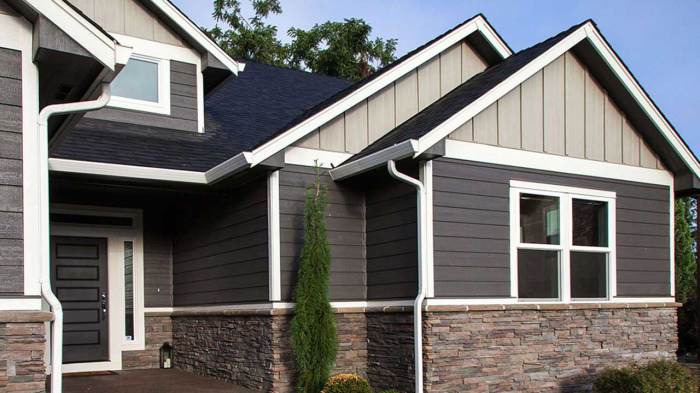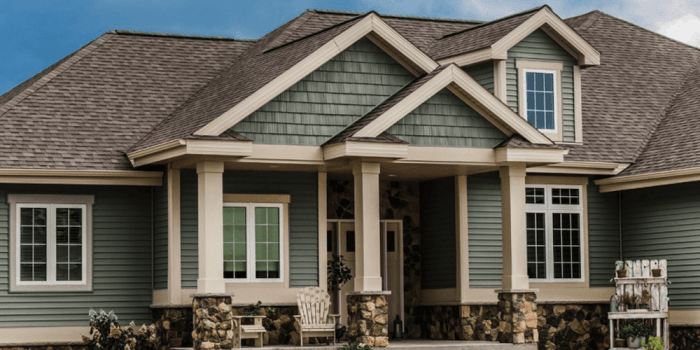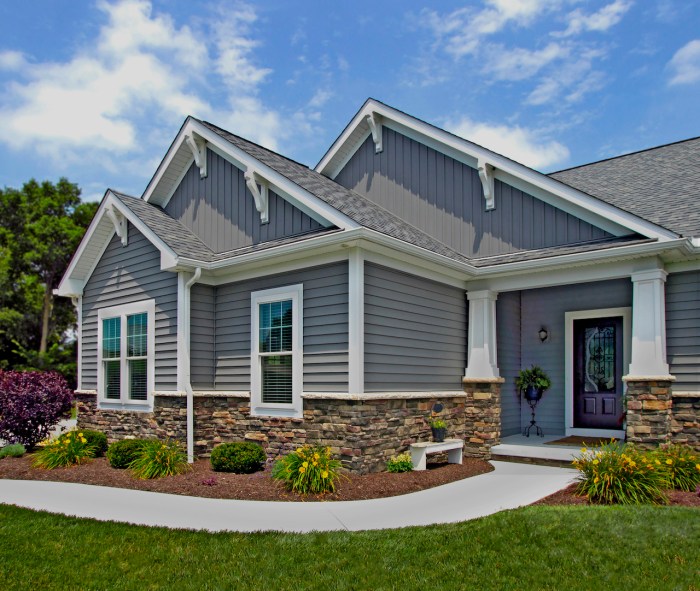Exploring the world of siding options for homes can be both exciting and overwhelming. From traditional wood to modern fiber cement, each material comes with its own set of advantages and drawbacks. Let's dive into the realm of siding materials and discover the best options for your home.
Types of Siding Materials

When it comes to choosing siding materials for homes, there are several options available, each with its own unique characteristics and benefits. The most popular choices include vinyl, wood, fiber cement, and metal siding. Let's explore the pros and cons of each to help you make an informed decision for your home.
Vinyl Siding
Vinyl siding is a popular choice due to its affordability, versatility, and low maintenance requirements. It comes in a wide range of colors and styles, making it easy to customize the look of your home. However, vinyl may crack or fade over time, and it is not as durable as some other materials.
Wood Siding
Wood siding offers a natural and timeless look that many homeowners love. It is also environmentally friendly and can be easily painted or stained to match your preferences. However, wood siding requires regular maintenance, such as painting or sealing, to prevent rot and decay.
Fiber Cement Siding
Fiber cement siding is a durable and low-maintenance option that resists rot, fire, and insects. It is available in a variety of textures and colors, mimicking the look of wood or stucco. While fiber cement siding is more expensive than vinyl or wood, it is a long-lasting and energy-efficient choice.
Metal Siding
Metal siding, such as aluminum or steel, is known for its strength, durability, and resistance to weather elements. It is also lightweight and easy to install, making it a popular choice for modern and industrial-style homes. However, metal siding may dent or scratch easily, and it can be prone to rust if not properly maintained.Consider the climate, architectural style, and budget of your home when choosing the right siding material.
Each option has its own set of advantages and drawbacks, so weigh them carefully before making a decision. Remember to factor in the long-term maintenance requirements and durability of the siding to ensure your home remains beautiful and protected for years to come.
Factors to Consider When Choosing Siding
When selecting siding for your home, there are several important factors to consider to ensure you make the right choice that fits your needs and preferences.
Climate Influence on Siding Choice
The climate of your region plays a crucial role in determining the best siding material for your home. For example, in areas with high humidity levels, vinyl siding may be a better choice as it is resistant to moisture and mold.
On the other hand, in regions with extreme temperature variations, fiber cement siding offers better durability and resistance to heat and cold.
Impact of Cost and Budget
Cost and budget considerations are essential when choosing siding for your home. While some materials like vinyl siding are more affordable upfront, they may require more frequent maintenance and replacement over time. On the other hand, premium materials like natural wood siding or fiber cement may have a higher initial cost but offer better longevity and durability, potentially saving you money in the long run.
Importance of Aesthetics and Curb Appeal
The aesthetic appeal of your home is greatly influenced by the choice of siding material. Different materials offer various textures, colors, and styles that can enhance the overall look of your home. It is important to choose siding that complements the architectural style of your home and adds to its curb appeal.
Energy Efficiency and Insulation Properties
The energy efficiency and insulation properties of siding materials can have a significant impact on your home's overall energy consumption and comfort. Materials like insulated vinyl siding or fiber cement siding can help improve the insulation of your home, reducing heat loss in winter and heat gain in summer.
This can lead to lower energy bills and a more comfortable living environment.
Installation Methods and Techniques

When it comes to installing siding on a home, there are several important steps to follow to ensure a successful and long-lasting result. Whether you choose to tackle the project yourself or hire a professional, proper installation techniques are key to the durability and appearance of your home's exterior.
Steps in Siding Installation:
- Prepare the surface by removing old siding, repairing any damage, and ensuring a smooth and clean substrate.
- Measure and cut the siding panels to fit, making sure to leave space for expansion and contraction.
- Install the siding according to the manufacturer's instructions, starting from the bottom and working your way up.
- Finish with trim pieces around windows, doors, and corners for a polished look.
Tips for DIY vs. Hiring a Professional:
- DIY: Consider your skill level, available time, and tools before taking on a siding project yourself. Start with a small area to practice before tackling the entire house.
- Professional: Hiring a siding contractor can save time and ensure a high-quality installation. Obtain multiple quotes and check references before making a decision.
Importance of Insulation and Moisture Barriers:
Proper insulation and moisture barriers are essential during siding installation to prevent issues such as mold, rot, and energy loss. Insulation helps regulate temperature inside the home, while moisture barriers keep water out and protect the structure.
Maintaining Proper Ventilation:
- Ensure there is adequate ventilation behind the siding to allow for airflow and prevent moisture buildup. This can be achieved through vents, gaps in the siding, or breathable underlayment.
- Regularly inspect and maintain the ventilation system to avoid any blockages or damage that could lead to moisture problems.
Environmental Impact and Sustainability
When it comes to choosing siding for your home, considering the environmental impact and sustainability of the materials is crucial. Opting for eco-friendly siding options not only benefits the environment but also contributes to a healthier living space for you and your family.
Eco-Friendly Siding Options
- Bamboo Siding: Bamboo is a rapidly renewable resource that can be harvested sustainably without causing harm to the environment. It is durable, lightweight, and biodegradable.
- Recycled Vinyl Siding: Made from recycled materials, vinyl siding reduces waste and energy consumption. It is low-maintenance and long-lasting, making it a sustainable choice.
- Cork Siding: Cork is a natural insulator that is harvested from the bark of cork oak trees without harming them. It is a renewable material that offers thermal and acoustic insulation properties.
Recyclability and Longevity of Siding Materials
Choosing siding materials that are recyclable and have a long lifespan is essential in reducing waste and minimizing the environmental impact. Materials like aluminum, steel, and fiber cement are highly recyclable and can last for decades, reducing the need for frequent replacements.
Choosing Sustainable Siding Products
- Look for siding products that are certified by recognized environmental organizations such as the Forest Stewardship Council (FSC) or the Green Building Initiative (GBI).
- Consider the energy efficiency and insulation properties of the siding material to reduce heating and cooling costs, ultimately lowering your carbon footprint.
- Opt for locally sourced materials to support the local economy and reduce transportation emissions associated with long-distance shipping.
Certifications and Standards
When selecting environmentally friendly siding, be sure to check for certifications and standards that indicate the sustainability of the product. Look for labels such as Energy Star, LEED certification, or Cradle to Cradle certification, which ensure that the siding meets specific environmental criteria.
Ultimate Conclusion

As we wrap up our discussion on the best siding for homes, it's clear that making the right choice involves considering factors like durability, aesthetics, and environmental impact. By weighing these aspects carefully, you can ensure that your home not only looks great but also stands the test of time.
Answers to Common Questions
What is the most durable siding material?
Vinyl siding is known for its durability and low maintenance, making it a popular choice among homeowners.
How does climate affect siding choice?
Climate plays a crucial role in selecting siding, as certain materials perform better in specific weather conditions. For example, fiber cement is ideal for humid climates.
Are metal sidings energy-efficient?
Metal sidings can be energy-efficient as they reflect sunlight, reducing heat absorption in the home.









